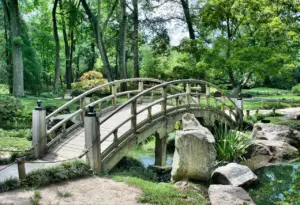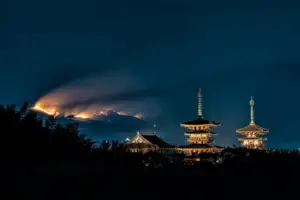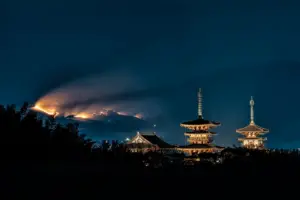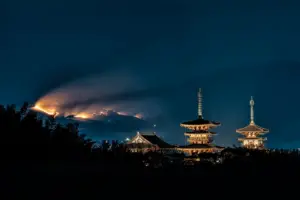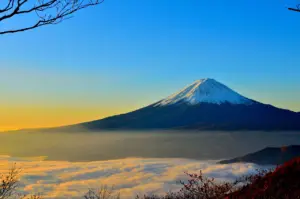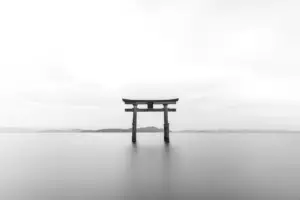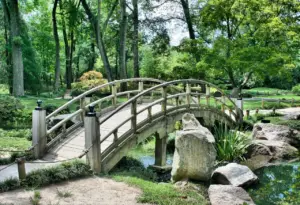Are you planning a trip to Japan and looking for a destination that will take your breath away? Look no further than Nara, a city located in the Kansai region of Japan that is home to some of the most beautiful temples and shrines in the country.
With a history dating back over 1,300 years, Nara is a treasure trove of cultural and religious wonders that are sure to leave you awe-inspired.
As you explore Nara, you’ll come across seven particular temples and shrines that stand out for their beauty, charm, and historical significance.
From the massive bronze Buddha statue at Todai-ji Temple to the serene gardens of Toshodai-ji Temple, each of these sites has its own unique character and appeal.
Whether you’re a history buff, a spiritual seeker, or simply someone who appreciates stunning architecture and natural beauty, you’re sure to fall in love with these seven beautiful temples and shrines in Nara.
Key Takeaways
- Nara’s temples and shrines are recognized as a UNESCO World Heritage Site and have a history dating back over 1,300 years.
- Each temple and shrine in Nara has its own unique design elements, with wood being a distinctive feature and pagoda-style roofs often having multiple tiers.
- Notable temples and shrines in Nara include Todai-ji Temple with its immense bronze Buddha statue, Kasuga-taisha Shrine with its thousands of lanterns and dense forest, Horyu-ji Temple with some of Japan’s oldest cultural treasures, and Kofuku-ji Temple with a stunning five-story pagoda.
- Nara’s temples and shrines have a connection to Chinese Buddhism and Shingon Buddhism, and Shinto and Buddhism were often practiced together in Japan.
Todai-ji Temple
The Todai-ji Temple is a must-visit destination for those seeking to immerse themselves in the rich cultural heritage of Nara. Renowned for its immense bronze Buddha statue, the temple is truly impressive with its sheer size. It is one of the largest wooden structures in the world and it’s hard not to be awed by its grandeur.
Once inside, you’ll be greeted by the sight of the Daibutsu, or Great Buddha, which is truly breathtaking. The statue is over 15 meters tall and weighs around 500 tons. An incredible feat of engineering for the time it was built. As you stand before the statue, you can’t help but be struck by the sense of peace and serenity that seems to emanate from it.
It’s an experience that you’ll never forget and one that will stay with you long after you’ve left the temple.
Kasuga-taisha Shrine
Located in the eastern part of Nara Park, Kasuga-taisha Shrine is a must-visit for anyone interested in Japanese history and culture. This ancient Shinto shrine was founded in 768 and is famous for its thousands of stone and bronze lanterns that line the pathways leading up to the shrine. The lanterns are lit twice a year during the Setsubun Mantoro festival, creating a magical and enchanting atmosphere.
The shrine is dedicated to four deities and is surrounded by a dense forest of towering cedar trees, adding to its serene and mystical ambiance. Visitors can explore the grounds and admire the beautiful architecture of the shrine’s buildings, including the main hall which is adorned with vibrant vermilion paint and intricate wood carvings. A visit to Kasuga-taisha Shrine is an unforgettable experience that will leave you with a deep appreciation for Japan’s rich cultural heritage.
| Lanterns | Cedar Trees |
|---|---|
| Thousands of stone and bronze lanterns line the pathways | The shrine is surrounded by a dense forest of towering cedar trees |
| Lit twice a year during the Setsubun Mantoro festival | Adds to the shrine’s serene and mystical ambiance |
The table above highlights two of the most striking features of the shrine – the lanterns and the cedars. As you walk along the paths, the lanterns guide your way and create a sense of wonder and awe. The cedars, on the other hand, provide a sense of peace and tranquility, reminding you of the deep connection between nature and spirituality in Japan. Make sure to add Kasuga-taisha Shrine to your list of must-visit places in Nara.
Horyu-ji Temple
When you visit Nara Park, don’t miss the chance to explore Horyu-ji Temple, where you’ll be transported back in time to the 7th century. This UNESCO World Heritage Site is one of Japan’s oldest temples, and it houses some of the country’s most important cultural treasures.
As you enter the grounds of Horyu-ji Temple, you’ll first come across the impressive five-story pagoda, which is the oldest wooden structure in Japan.
Inside the temple complex, you’ll find a treasure trove of Buddhist art and artifacts, including statues of the Buddha and other deities, intricate carvings, and ancient sutras.
Here are three things not to miss during your visit to Horyu-ji Temple:
-
The main hall, known as the Kondo, is home to some of the oldest surviving wooden buildings in the world. Take a moment to admire the intricate wooden carvings and beautiful architecture.
-
The Yumedono, or Hall of Dreams, is a small octagonal building that is said to contain a statue of the Buddha that can grant wishes. Visitors aren’t allowed inside, but you can still admire the building from the outside.
-
The Tamamushi Shrine is a small, jewel-like building that is covered in colorful lacquer and is one of the oldest examples of Japanese architecture. Inside, you’ll find beautiful Buddhist images and carvings that are still in remarkably good condition after over 1,300 years.
Kofuku-ji Temple
You’re in for a treat at Kofuku-ji Temple, where you’ll feel a sense of wonder as you explore the vast grounds and marvel at the intricate details of the ancient architecture. This temple, which was first constructed in the 8th century, is the second largest temple complex in Nara. It’s home to a stunning five-story pagoda that stands at 50 meters tall, making it the second tallest pagoda in Japan.
As you wander the grounds, be sure to take a closer look at the temple’s main hall, which houses a statue of Yakushi Nyorai, the Buddha of healing. It’s said that this statue has the power to heal not only physical ailments, but also mental and emotional ones. Take a moment to offer a prayer or wish for yourself or loved ones as you admire the golden beauty of the statue. And don’t forget to check out the table below, which highlights some of the key features of Kofuku-ji Temple.
Yakushi-ji Temple
Get ready to be transported back in time as you step inside Yakushi-ji Temple, where you’ll be mesmerized by the ancient architecture and stunning artwork.
This temple is one of the oldest in Japan, dating back to the 7th century. As you walk through the gates, you’ll be greeted by a serene atmosphere that will make you forget about the hustle and bustle of modern life.
The main hall of Yakushi-ji Temple is a designated National Treasure of Japan, and for good reason. The intricate carvings on the wooden beams and the golden Buddha statue are a testament to the skill and craftsmanship of the ancient Japanese artisans.
Take a moment to admire the details of the artwork and the peaceful atmosphere of the temple, and you’ll feel rejuvenated and inspired. A visit to Yakushi-ji Temple is a must for anyone interested in Japanese history and culture.
Gango-ji Temple
Step into the ancient world at Gango-ji Temple, where you’ll be transported back in time to experience the rich history and culture of Japan.
This temple, located in the heart of Nara, was founded in the 6th century and is one of the oldest temples in Japan.
As you walk through the gates, you’ll be greeted by a serene atmosphere and a sense of tranquility that envelops the entire temple grounds.
One of the most striking features of Gango-ji Temple is the pagoda, which stands tall at five stories high. It’s one of the few remaining structures from the Nara period and is a testament to the architectural prowess of the time.
Inside the temple, you’ll find a treasure trove of artifacts and artworks that date back centuries. From intricate carvings to stunning paintings, every inch of the temple is adorned with beauty and history.
Gango-ji Temple is a must-visit for anyone interested in Japanese history and culture.
Toshodai-ji Temple
As you continue your exploration of Nara’s beautiful temples and shrines, you can’t miss the Toshodai-ji Temple.
This UNESCO World Heritage Site boasts a unique architecture and design that sets it apart from other temples in the area.
Built in the 8th century, the temple has a strong connection to Chinese Buddhism and is a must-see for anyone interested in Buddhist history and culture.
UNESCO World Heritage Site
You’ll be transported back in time as you explore the UNESCO World Heritage Site of Nara’s stunning temples and shrines. Among these remarkable sites is the Toshodai-ji Temple, which is recognized as one of the oldest and most historically significant temples in Japan.
Located just a short distance from the city center, this temple stands as a symbol of the country’s rich cultural heritage and spiritual traditions.
As you wander through the temple grounds, you’ll be struck by the sheer beauty of the architecture and design. The main hall, known as the Kondo, is particularly impressive, with its intricate carvings and soaring columns.
You’ll also have the opportunity to visit the nearby museum, which houses a wealth of artifacts and information about the temple’s history and significance. Whether you’re a history buff, a spiritual seeker, or simply a lover of beauty and craftsmanship, the Toshodai-ji Temple is a must-see destination during your visit to Nara.
Unique Architecture and Design
Now that you know about Nara’s UNESCO World Heritage Sites, let’s delve into the unique architecture and design of its temples and shrines. As you explore the city, you’ll notice that the structures here are quite different from those you may have seen in other parts of Japan.
One of the most distinctive features of Nara’s temples and shrines is their use of wood. Many of the buildings here are made entirely of wood, with intricate carvings and designs that showcase the skills of the craftsmen who built them. The wooden structures are also designed to blend seamlessly with the natural surroundings, creating a harmonious environment that feels like it’s part of the landscape. To give you a better idea of the unique design elements you’ll encounter, take a look at the table below:
| Temple/Shrine | Notable Design Features |
|---|---|
| Todai-ji | World’s largest wooden building; intricate wooden carvings |
| Kasuga Taisha | Bright vermilion color; elaborate lanterns |
| Kofuku-ji | Five-story pagoda; ornate wooden carvings |
| Horyu-ji | Oldest wooden building in the world; intricate wooden carvings |
| Yakushi-ji | Symmetrical design; Chinese-style architecture |
As you can see, each temple and shrine has its own unique design elements that make it stand out. Whether you’re admiring the intricate wooden carvings at Todai-ji or marveling at the bright vermilion color of Kasuga Taisha, you’re sure to be captivated by the beauty and craftsmanship of Nara’s temples and shrines. So, take your time as you explore and soak in the unique architecture and design that this city has to offer.
Connection to Chinese Buddhism
Nara’s temples and shrines have a unique connection to Chinese Buddhism, reflected in their architectural designs and religious practices.
The influence of Chinese Buddhism can be seen in the use of pagoda-style roofs, which were introduced to Japan from China. These pagoda-style roofs often have multiple tiers, with each tier representing one of the elements from Buddhist cosmology. Popular tourist sites such as Todai-ji Temple and Kofuku-ji Temple showcase these roofs.
Chinese Buddhism also influenced religious practices at Nara’s temples and shrines. Shinto and Buddhism were often practiced together in Japan, but it was the Chinese influence that led to the creation of a unique form of Buddhism called Shingon Buddhism. This form of Buddhism emphasizes the use of mantras and mandalas and can be seen at the Kasuga-taisha Shrine in Nara.
Overall, the connection to Chinese Buddhism adds a rich and diverse history to Nara’s temples and shrines, making them a must-see destination for anyone interested in Japanese culture and religion.
Frequently Asked Questions
What is the significance of the animals depicted in the architecture of Todai-ji Temple?
The animals depicted in the architecture of Todai-ji Temple hold great significance. As you enter the temple, you’ll notice two fierce-looking guardians on either side of the entrance, which are believed to ward off evil spirits.
Once inside, you’ll see a massive bronze statue of the Buddha surrounded by beautifully carved wooden pillars. These pillars depict various animals, including elephants, lions, and deer. Each animal holds a symbolic meaning, such as the elephant representing strength and wisdom, the lion representing courage, and the deer representing gentleness.
These depictions not only add to the stunning beauty of the temple but also serve as a reminder of the values and virtues that are essential to Buddhists.
Are there any special rituals or ceremonies that take place at Kasuga-taisha Shrine?
At Kasuga-taisha Shrine, you’ll find a variety of traditional Japanese rituals and ceremonies taking place throughout the year.
One of the most notable events is the Setsubun Festival, which takes place annually on February 3rd. During this festival, people throw roasted soybeans to drive away evil spirits and bring good luck for the upcoming year.
Additionally, the shrine holds a lantern festival in August, where thousands of lanterns are lit to create a stunning display of light.
Visitors can also witness traditional Shinto weddings and other ceremonies throughout the year. Whether you’re interested in experiencing Japanese culture or simply admiring the beauty of the shrine, Kasuga-taisha is a must-visit destination in Nara.
How has Horyu-ji Temple been able to preserve its ancient architecture and artifacts for so long?
Horyu-ji temple has been able to preserve its ancient architecture and artifacts for so long due to a combination of factors.
First and foremost, the temple was constructed using the finest materials of the time, including cypress wood and copper roofing, which have held up remarkably well over the centuries.
Additionally, the temple has undergone numerous renovations and restorations over the years, which have helped to maintain its structural integrity.
The temple also has a dedicated team of caretakers who work tirelessly to ensure that the buildings and artifacts are properly maintained and protected from the elements.
Finally, the temple has been designated a UNESCO World Heritage site, which has helped to raise awareness of its cultural significance and attract funding for preservation efforts.
All of these factors have contributed to Horyu-ji temple’s impressive longevity, making it a must-see destination for anyone interested in ancient Japanese history and architecture.
What is the history behind the iconic five-story pagoda at Kofuku-ji Temple?
The iconic five-story pagoda at Kofuku-ji Temple has a rich history dating back to the 8th century. Originally built in Kyoto, it was moved to Nara in the 15th century and has been reconstructed several times due to fires and natural disasters.
Each level of the pagoda represents a different element, with the top level symbolizing space. The pagoda is an impressive sight to behold, standing at over 50 meters tall and adorned with intricate carvings and decorations.
It’s a must-see attraction when visiting Nara and provides a glimpse into the rich cultural heritage of Japan.
Is Yakushi-ji Temple open to the public for worship, or is it strictly a historical site?
Yes, Yakushi-ji Temple is open to the public for worship and not just a historical site. As one of the oldest and most significant temples in Japan, it’s an important spiritual center for many people.
Inside the temple, you can find various Buddha statues and other religious artifacts that are used for worship. Additionally, the temple grounds are peaceful and serene, making them a great place to reflect and meditate.
Overall, if you’re looking to experience the religious and spiritual side of Nara, Yakushi-ji Temple is definitely worth a visit.
Conclusion
So there you have it, seven stunning temples and shrines to explore in Nara. Each one has its own unique history and significance, making for an unforgettable cultural experience.
From the massive Buddha statue at Todai-ji Temple to the peaceful gardens at Toshodai-ji Temple, there’s something for everyone to enjoy.
Don’t forget to take your time and fully immerse yourself in the beauty and serenity of these sacred places. Whether you’re a history buff, a spiritual seeker, or simply someone who appreciates stunning architecture and natural surroundings, Nara’s temples and shrines are a must-see destination.
So what are you waiting for? Start planning your trip to Nara today!













